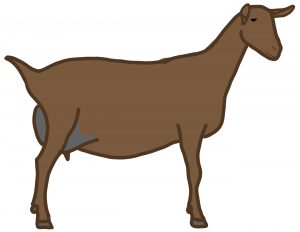Australian Brown
History
All-brown goats had appeared from time to time in dairy herds in Australia, but it was not until the 1990s that some breeders decided to keep them and try to establish them as a breed. Browns had come from Saanen, Toggenburg and British Alpine backgrounds. At the beginning of the 1990s all-brown stock were to be found in three states in sufficient numbers to enable breeders to exchange stock and begin a breeding programme.
In Victoria a large enough herd was developed for brown to brown matings to occur. These matings produced consistent type and colour and it was determined that the solid coat was recessive to white Swiss markings. They had good udders, were high producers of milk and had good butterfat and protein levels. They also had extended lactations and here noted for their ease of milking.
In April 1996 the DGSA provided an Experimental Listing that included an ‘All Brown’ standard. This register operated for ten years before being reviewed. During this time numbers of Browns increased and they were given access to the show ring in Victoria by the introduction of ‘any other variety’ classes. They were also permitted into udder classes to be assessed alongside existing breeds.
In May 2006 the all-browns were accepted by the DGSA as a breed under the name Australian Brown.
Breed standard
GENERAL APPEARANCE (style & quality): Elegant, with dairy quality. Fine without tending to weakness. An alert expression and stance combined with a docile temperament. Does feminine, bucks obviously masculine in appearance.
HEAD (skull eyes, ears, mouth, nostrils):Head slender and medium length, facial line straight, dished or slightly raised bridge. Eyes full and set well apart. Ears neat to long, erect and pointing slightly forward.Polled or neatly disbudded. Side profile should show no tendency to undershot or overshot jaw.
NECK: Blending smoothly into shoulders. Does long and fine, bucks fine and strong, not coarse. With or without tassels.
BACKLINE: Back strong, straight and rising to the hips or horizontal.
FOREQUARTERS: Withers fine and high, blending smoothly and finely into shoulders. Chest wide and deep in bucks, showing medium width and depth in does.
BODY (barrel): Long, deep wedge shaped. Well-sprung ribs, good abdominal capacity.
HINDQUARTERS: Gradual fall from hips to tail, good width between hips and thurls. Rump broad and strong. Pin bones wide and prominent.
LEGS (hooves): Long, strongly-boned legs, but not coarse or heavy. Front legs straight and parallel from front and side. Hindlegs straight and parallel viewed from rear, hocks slightly bent when viewed from side. Pasterns fairly short and strong. Hooves sound and well-shaped, dark brown or black horn.
UDDER: Back attachment high and broad. Fore attachment carried well forward and blending smoothly into abdomen. Not pendulous or unduly divided. Showing good capacity. Skin brown to soft brown-black, softly textured.
TEATS: Of adequate size for ease of hand milking, well attached and distinct from the udder. Set well apart, pointing slightly forward and down, not outward. Allowing good milk flow.
TESTICLES: Scrotum well attached, relatively even and not divided or unduly pendulous. Carrying two testes.
RUDIMENTARY TEATS: Two, set wide apart, slightly to the fore and sides of the scrotum, of good size but not over-developed, unless the buck is milking.
SIZE (height): Does 81 cm (32 inches). Bucks 94 cm (37 inches).
COAT: Smooth and short, does may have a light fringe along backline and on legs. Bucks may have a longer coat.
COLOUR: Uniform, silver/ fawn to chocolate, sparsely scattered white, cream, sandy or dark hair throughout, but not detracting from overall brown appearance.
DIFFERING FROM THE IDEAL (found and recognised): Excessively raised bridge from nose. Heavy head. Flared nostrils. Horned. Uneven tassels. Rose brown skin on udder. Long or very short pasterns.
FAULTS: Steeply sloping or rounded rump. Cow or sickle hocks. Post legged. Roached back. Sway back. Size differing substantially from ideal. Dropped pasterns. Poor feet. Splay feet. Uneven gait. Weak or narrow chest. Shallow body. Low-set ears. Lack of femininity in does. Lack of masculinity in bucks. Lack of blending in forequarters. Dewlaps. Keel chested. Tan skinned udder. Fleshy, pendulous or unduly divided udder. Uneven udder in adult. Pocket in udder. Teats small, thin, bulbous, unbalanced, ill-defined. Lack of dairy quality. Lack of milking capacity. Small spots of other than main body colour. Divided uneven or unduly pendulous scrotum. Loosely attached shoulders and dropped withers. Ewe necked, Cobbiness. Spots on barrel smaller than a 10cent coin.
DISQUALIFICATIONS: Obviously undershot or overshot jaw (side profile). Wry face. Double orifices. Double or supernumerary teats. Patches of other than main body colour. Black coat. Grey underbelly. Pendulous ears. Any white “Swiss” markings or facial stripes. Undescended testicle(s) or one testicle only.Patches on barrel larger than a 10cent coin.

